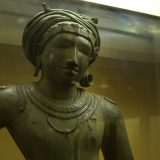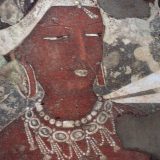On the Wood of Many Hues
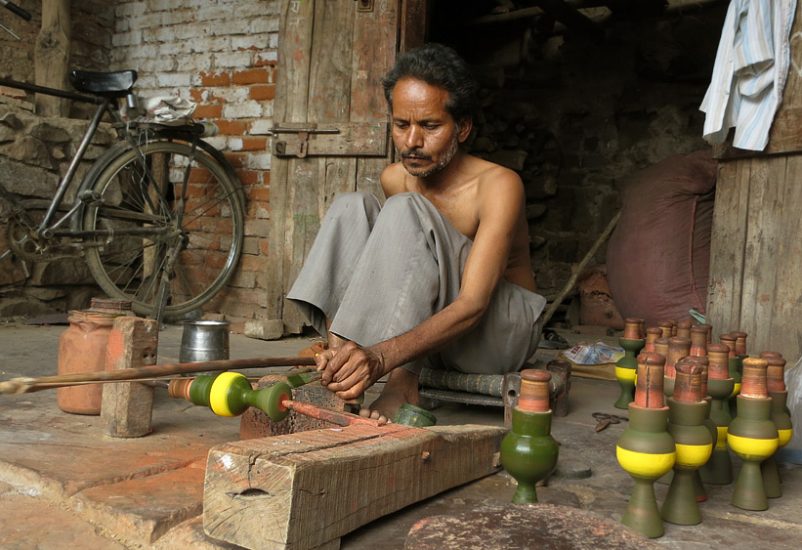
The sky is still radiant from the setting sun when the people of Sheopur begin trickling out of their thatched houses. They are attired in extravagant sarees and dhoti-kurtas tonight, intended for the celebration of Holika Dahan. Excited whispers accompany them as they gather around a heap of wooden sticks and badkulla that is set up in nearly every street. The children have a skip in their steps, their hands full of peanuts and revdi as they pop them occasionally in their mouths.
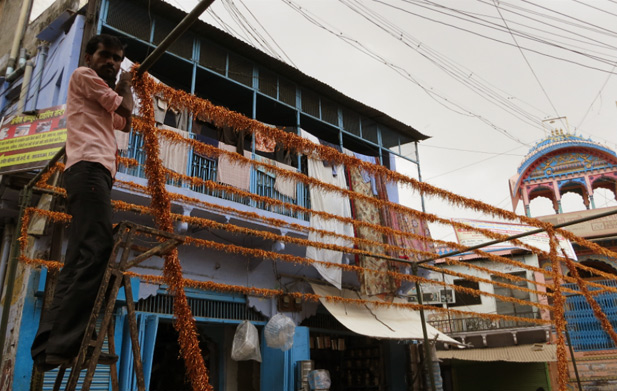
Momentary silence falls over the group when the dry wood is kindled. When no branch is spared, the roar of the people is slowly overshadowed by the roar of the bonfire. Hugs are passed around like candy and people murmur gratefully for the cleansing of their sins. The children circle the fire, throwing the extra revdi in the fire, watching the sesame seeds crackle in the heat. The fire isn’t even fully out when people start leaving. After all, the celebrations have barely begun.
Inside a crowdfunded tent, a group of men don clean pagris and hitch their dhotis up to their knees. The chime of the jhanj and the mridanga is soon accompanied by the earthy voices of the men, who are performing the traditional Ahiri dance. Amidst this melody of folk songs, a man slips in the circle created by these men, wearing a long skirt and a veil that goes past his chin. Shouts of appreciation go up as he dances fluidly, the shiny, lacquered bangles on his arms catching the dim light. These bangles keep clanging late into the night, until the stars rose high, blinking at the town lazily.
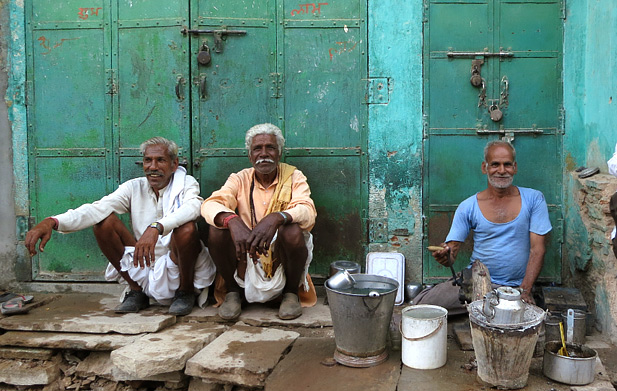
By the time these people, go back to work, the festival of Holi is over. The town is just waking up as they make their way to work, hands still tinged pink from the colours. The Sheopur Fort stands steady as they pass it, its ancient framework drenched in a rich history. Their ancestors have lived through hundreds of years of changing monarchs—from the Gaurs who established it to the Scindias who took it last. This barrage of changing sovereigns has left the town of Sheopur, Madhya Pradesh in an amalgamation of different faiths and cultures, evident in their faiths and garbs.
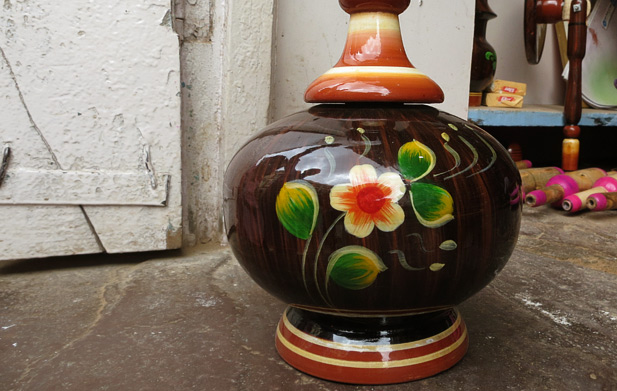
A testament to the rich culture of Sheopur is the craft of lacquerware which has about 400 years of history hidden in its glinting curves. It has come a long way from the era when the mythical warriors called Pandavas were just about slaughtered in the infamous Lac palace. It has been through a time when the craft was practiced to amuse Baghelkhandi kings. Now, this craft is practiced by families, and small and medium scale industries alike, keeping the age-old tradition going.
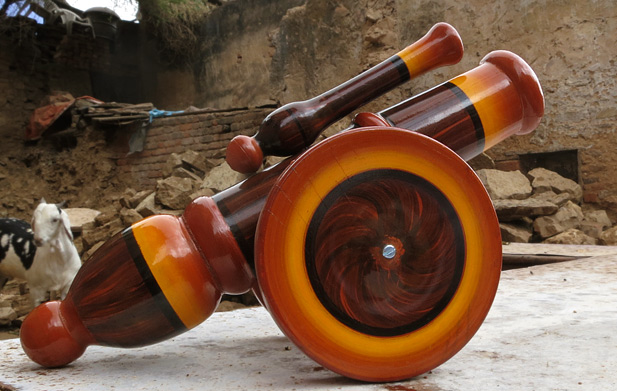
When the people reach their workplace, they see that the branches of the nearby trees are covered in layers of resin from the millions of crimson red insects. This resin, which eventually turns into Lac, has been part of the Indian culture since times long gone. Ancient texts like the Vedas and the epic Mahabharata mention it too. Its existence in the contemporary world may have been prioritised later in Ain-i-Akbari in 1590 AD for the first time, but its importance in medical therapies has been emphasised in Ayurveda even earlier. Another thing that lends to the uniqueness of the Lac in India is its source. Rather than the Khus tree sap that is globally used, resin from insects like Laccifer Lacca, Carteria Lacca, and Tachardia Lacca is used in India.
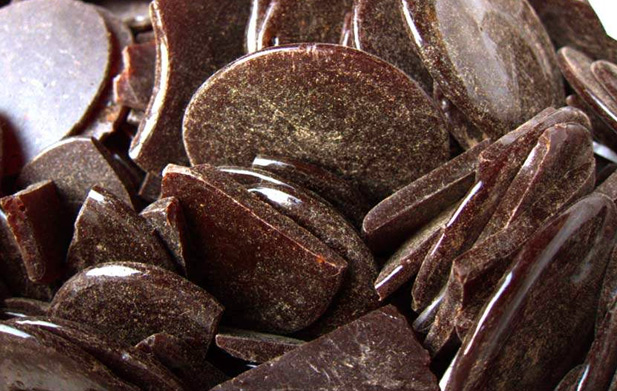
The workers harvest this resin by scraping these layers off in the form of sticklac. They crush these, sieving and washing them several times to remove impurities until the Lac shows up in its natural red colour. The Lac that they use is a medium brown colour, indicative of its good quality. Had it been dark black, it would’ve been of the poorest quality. On the other hand, button Lac, light and golden coloured, is the finest quality.
A pot bubbles with boiling water and the women of the community put the raw Lac in. The Lac melts in the heat, becoming sticky and elastic, and is left to cool down until it’s pliable. The sound of wood on the stone floor reverberates through the place as the Lac gets battered. The Lac that is uncoloured, called Pure Lac, is a paradoxical wonder, simply enhancing the natural hue of the wooden piece.
Some finished pieces though, whether they are pipes or window frames or bedposts, need colour. These sleek pieces end up prismatic in a rainbow of yellow, green, red, and silver grey. Should the finished item need these colours, the women fetch pigments of oxides of iron, zinc, and magnesium. While the Lac is being battered, these pigments are added until finally, it turns thick and solid which are then cut into usable sticks.

When the sticks are prepared, the men take out the wooden logs that have been kept for seasoning. These logs are of the Dhundhi wood, native to their town. Since this wood is innately moist, it is cut and seasoned by storing them away from sunlight and heat, with proper air ventilation. The moisture content in each log is different, leading to different storage times. Since the log the men take out is ready, its softness is shaped into a cylinder by chiseling out the inessential wood.
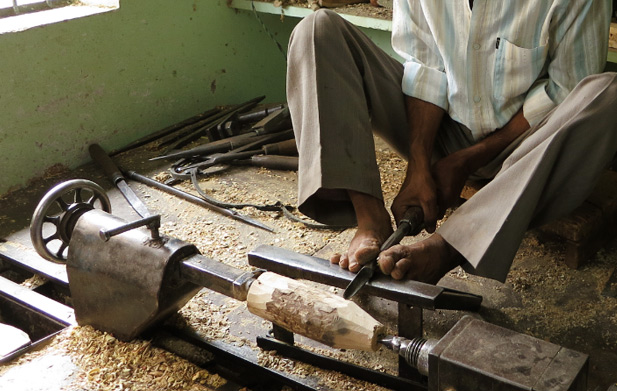
A machine lathe called Patri lies on the ground and along with it lies an assortment of local tools—Matna, Barma, Aari, Naira, and Thikra. This traditional lathe is a small phenomenon of wood and stone, being much easier to operate for the craftsmen. The cylindrical wood pieces on the lathe start spinning as the tools mold it into cradle posts or flower vases or tens of different forms. The different tools work through the contours of the soft wood, making grooves and cuts. When it is done, sandpaper smooths out its surface.
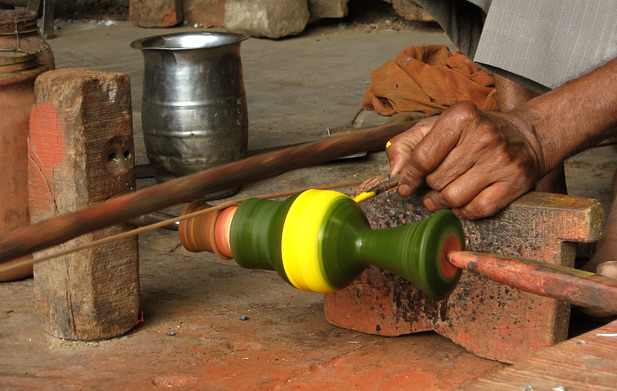
The pieces spin once again to apply the coat of lacquer. The sticks of Lac are pressed against the constantly moving surface. The friction of it begins melting the sticks and colour blooms onto the wood as the Lac sticks to it. If the natural colours do not suffice, the artisans turn to acrylics, staining the wood in the brightness of different hues.
To give these pieces the translucent, glossy look that they are famed for, they are buffed with kewda ka patta (Talegari or screw pine leaves). They can substitute these with chapdi wax sourced from Rajasthan, chandrak, or kewra oil for a final finish to the wooden pieces. At last, the finished piece is removed from the hand lathe and further ornamented.
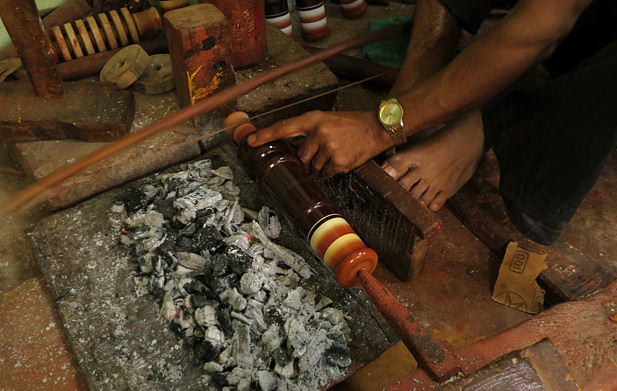
It is twilight when the finished goods are ready to be sold at the local bazaar or be catered to bigger traders. The men make their way home, hands exhausted and hearts full of content at a day well spent. The children play with their wooden tops near the gleaming stools that were used in marriage ceremonies. They all enjoy the leftover malpuas as deft hands churn out Rotis with colourful rolling pins. The versatility of this craft, whether for decorative purposes or practical, is astounding.
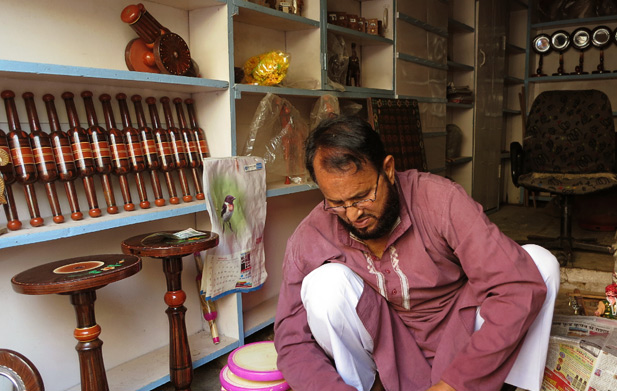
The mood of the evening turns somber as the matter of sales comes up. Their wrinkled hands remember the time when plastic hadn’t taken over. The cheap and equally shiny toys have become the attention grabber of every passerby. However, they cannot capture the essence of lacquer and it is this thought that pushes the craftsmen to do more. They have begun incorporating the bright colours of the plastic toys in their art. They even consult young designers for new ideas.
It is nothing short of a wonder that something that these craftsmen created so lovingly has made so many people happy in the past. Their only wish is that they may continue to do so….
For more detail visit Research & Archive

